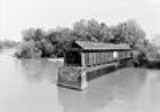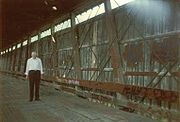
Bell Ford Bridge
Encyclopedia
The Bell Ford Post Patented Diagonal "Combination Bridge", often simply called the Bell Ford Bridge or Bell Ford Covered Bridge, is a dilapidated covered bridge
located in Jackson County, Indiana
, northwest of Seymour, Indiana
. The bridge originally passed over the East Fork of the White River
on a former alignment of State Road 258, and was placed on the National Register of Historic Places
on March 25, 2005.
 The bridge was originally built in 1869. Built in two sections, the wood and iron bridge measured 325 feet long. It reflects a time when the construction of bridges began switching from wood to iron / steel, every tensile web in the trusses made of iron, every compression member made from wood. The now unusual use of both materials has made it said that the Bell Ford Bridge is "the best representation of the American engineering “combination” bridge form". Until 1970 it was regularly used by both cars and animals. The western span collapsed in February 1999 during a windstorm, and the eastern span collapsed on January 2, 2006, nine months after it made the National Register. Its collapse meant that no combination variant Post Truss remained standing worldwide.
The bridge was originally built in 1869. Built in two sections, the wood and iron bridge measured 325 feet long. It reflects a time when the construction of bridges began switching from wood to iron / steel, every tensile web in the trusses made of iron, every compression member made from wood. The now unusual use of both materials has made it said that the Bell Ford Bridge is "the best representation of the American engineering “combination” bridge form". Until 1970 it was regularly used by both cars and animals. The western span collapsed in February 1999 during a windstorm, and the eastern span collapsed on January 2, 2006, nine months after it made the National Register. Its collapse meant that no combination variant Post Truss remained standing worldwide.
After the Bell Ford Bridge's January 2006 collapse, Jackson County Commission President Gary Darlage said: "There is nothing left of the Bell Ford Bridge and I will not spend another tax dollar on it. Ninety percent of the people in this county think it is asinine to even consider rebuilding that bridge. On July 25, 2007, United States Representative Baron Hill
announced that the National Historic Covered Bridge Preservation Program would be giving the Bell Ford Bridge and two other covered bridges in Jackson County $2.08 million total for restoration. $448,000 of the grant was for the Bell Ford Bridge.
 On August 19, 2008, the commissioners of Jackson County voted 3-0 to sell what remained of the bridge to an interest group who intended to rebuild the bridge at Fort Benjamin Harrison State Park in Indianapolis, Indiana
On August 19, 2008, the commissioners of Jackson County voted 3-0 to sell what remained of the bridge to an interest group who intended to rebuild the bridge at Fort Benjamin Harrison State Park in Indianapolis, Indiana
, over sixty miles (100 km) away from its current location. It would allow walkers and bikers to cross over Fall Creek. The restoration is expected to take two years and cost $2 million (USD), with a hope that federal grants will be available. It has been promised that historical markers will denote its history in Jackson County, but some preservationists in Jackson County decry it being moved, saying the grant money was already there to pay for its renovation in Jackson County. One thing that might stop the bridge from being moved is if Jackson County would have to repay $123,000 of federal money for design and restoration work it received to use on the bridge since 1999. In late May 2010 an Indiana Department of Transportation representative requested of Jackson County commissioners that a decision be made in the coming month.
Covered bridge
A covered bridge is a bridge with enclosed sides and a roof, often accommodating only a single lane of traffic. Most covered bridges are wooden; some newer ones are concrete or metal with glass sides...
located in Jackson County, Indiana
Jackson County, Indiana
Jackson County is a county located in the U.S. state of Indiana. As of 2010, the population was 42,376. The county seat is Brownstown.-History:...
, northwest of Seymour, Indiana
Seymour, Indiana
Seymour was the site of the World's First Train Robbery, committed by the local Reno Gang, on October 6, 1866 just east of town. The gang was put into prison for the robbery, and later hanged at Hangman's Crossing outside of town....
. The bridge originally passed over the East Fork of the White River
White River (Indiana)
The White River is a two-forked river that flows through central and southern Indiana and is the main tributary to the Wabash River. Via the west fork, considered to be the main stem of the river by the U.S. Board on Geographic Names, the White River is long.-West Fork:The West Fork, long, is...
on a former alignment of State Road 258, and was placed on the National Register of Historic Places
National Register of Historic Places
The National Register of Historic Places is the United States government's official list of districts, sites, buildings, structures, and objects deemed worthy of preservation...
on March 25, 2005.

After the Bell Ford Bridge's January 2006 collapse, Jackson County Commission President Gary Darlage said: "There is nothing left of the Bell Ford Bridge and I will not spend another tax dollar on it. Ninety percent of the people in this county think it is asinine to even consider rebuilding that bridge. On July 25, 2007, United States Representative Baron Hill
Baron Hill
Baron Paul Hill is the former U.S. Representative for , serving from 1999 to 2005 and from 2007 to 2011. He is a member of the Democratic Party....
announced that the National Historic Covered Bridge Preservation Program would be giving the Bell Ford Bridge and two other covered bridges in Jackson County $2.08 million total for restoration. $448,000 of the grant was for the Bell Ford Bridge.

Indianapolis, Indiana
Indianapolis is the capital of the U.S. state of Indiana, and the county seat of Marion County, Indiana. As of the 2010 United States Census, the city's population is 839,489. It is by far Indiana's largest city and, as of the 2010 U.S...
, over sixty miles (100 km) away from its current location. It would allow walkers and bikers to cross over Fall Creek. The restoration is expected to take two years and cost $2 million (USD), with a hope that federal grants will be available. It has been promised that historical markers will denote its history in Jackson County, but some preservationists in Jackson County decry it being moved, saying the grant money was already there to pay for its renovation in Jackson County. One thing that might stop the bridge from being moved is if Jackson County would have to repay $123,000 of federal money for design and restoration work it received to use on the bridge since 1999. In late May 2010 an Indiana Department of Transportation representative requested of Jackson County commissioners that a decision be made in the coming month.

